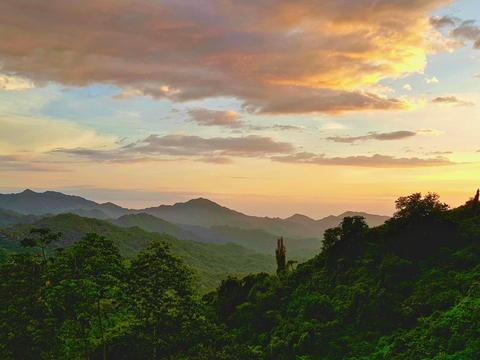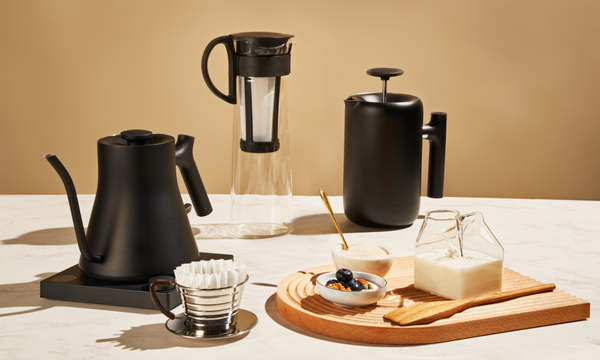What Are Coffees From Colombia Like?
Colombia is a diverse region with equally diverse—and tasty—coffees.
The country of Colombia has long been associated with coffee. In 1959, the National Federation of Coffee Growers of Colombia*, known in Spanish as Federación Nacional de Cafeteros or the FNC, created a functional coffee grower named Juan Valdez.
The character was part of a marketing strategy to distinguish 100% Colombian-grown coffee from other coffees that would blend various beans together. The idea was to communicate to consumers that Colombian coffee was special, unique, and worth seeking out on its own. Juan Valdez began appearing in print and TV ads* throughout the 60s, 70s, and 80s, and the campaign brought a lot of attention to the region.
But even without Juan Valdez, Colombian coffee is exceptional. From its unique harvest season to its diversity of growing regions and flavors, coffees from Colombia tend to be a barista favorite and manage to find a place on every roaster’s coffee lineup. In this article, we’ll talk about the history of Colombian coffeeand what makes the region a standout in the coffee world.
A Brief History
What is Colombian coffee? It’s unclear how exactly coffee got to Colombia (it’s likely due to colonization and trade routes), but it was first harvested by Jesuit priests in 1730. Colombia didn’t begin exporting Colombian coffee beans until a century later and is now the third-biggest producer of coffee*, after Brazil and Vietnam. In 2021, Colombia produced 12.6 million 60-kg bags, or about 1.6 billion pounds.
Colombia is one of the only countries that borders two oceans: the Atlantic in its northeast region and the Pacific in the west. It connects to Latin America by sharing a border with Panama and bordering several other countries, many of which grow coffee: Ecuador, Peru, Brazil, and Venezuela. Colombia almost exclusively grows arabica coffee beans (although it may also be common for other coffee growers to specialize in robusta beans).
Growing and Harvest

Colombia is an ideal country in Latin America to grow coffee for several reasons. The FNC website* notes three specific facts that support coffee production: one, the average temperature is between 17 and 23 degrees Celsius (between roughly 63-73 degrees Fahrenheit),; two, many places are mountainous and have slopes between 1,200-1,800 meters above sea level (this can vary, and some farms are as high as 2,000 meters above sea level),; three, the country gets about 78 inches of rainfall a year. Approximately 540,000 families make their living on coffee, and most coffee farmers are smallholder farms.
All these factors support coffee production and cultivation, and you can generally find coffee growing year round because of all the unique microclimates and the fact that coffee grows pretty much all over the country (there are a few regions to the west you might not traditionally find coffee, but from the northern to southernmost points of Colombia, you’ll find coffee growing). Most farms produce two harvests: the main harvest and what’s called the mitaca harvest six months later.
There are 32 regions within Colombia, and 20 of them are ideal for growing coffee. As mentioned above, coffee grows up and down the country, but Colombia’s most famous coffee-growing regions tend to be concentrated in the south, where there are higher elevations—in general, higher elevations mean that coffees are exposed to hot temperatures during the day and cooler ones at night, slowing the maturation process and allowing the beans to develop a more advanced flavor profile. Some of the ones you might see on a coffee bag are Nariño, Cacua, Hulia, and Tolima.
Approximately 540,000 families make their living on coffee, and Colombia has done a lot to advance the future of the coffee industry. Colombia’s National Coffee Research Centre (Cenicafé*) has developed a number of coffee cultivars that are resistant to roya, a coffee disease that kills plants, including Colombia, Castillo, Cenicafé 1, and Tabi. However, lots of farms still grow traditional coffee cultivars like Caturra and Typica.
Flavor and Preparation
What is the best way to drink Colombian coffee? Espresso vs coffee? Cold brew vs iced coffee? There is no right or wrong method.

Because of the diversity of growing regions, Colombia produces a wide variety of coffees with distinct flavors. Colombian coffees can be used for filter and espresso brewing and work well as single-origin offerings or with other beans to build the best Colombian coffee blend. In a way, you kind of can’t go wrong with Colombian coffee beans.
In general, Colombian coffees tend to be balanced and sweet with a medium weight and mouthfeel. These aren’t coffees that’ll disappear in milk (making them appropriate for espresso as a base for drinks like lattes and cappuccinos) but still have acidity and sweetness that make them stand out on their own.
Citrus is a common flavor note for Colombian coffees, but many are often described as sweet and complex—and because they’re not as delicate as some other coffees, they can withstand a variety of brew methods. The floral tones of an Ethiopian coffee might get lost in a French press, but the body of a Colombian coffee might be enhanced through this immersion brew method, for example (of course, this isn’t a rule, and lots of Ethiopian coffees are delicious on French press).
Colombia is also a hotbed for innovation, with farmers trying new experimental processes and playing with wild cultivars. Diego Campos won the World Barista Championships in 2021, representing Colombia and using a species called eugenioides, distinct from arabica and notably low in acidity but high in sweetness. Lots of farmers are also experimenting with fermentation methods, emphasizing and drawing out the sweetness and acidity in the beans.
Whatever coffee you get from Colombia, you’ll know it’ll be delicious, and its flexibility means you can enjoy it in a lot of different ways. From your morning espresso to your afternoon pour-over, Colombian coffees can shine in any cup.
Aside from Colombian coffee, there are plenty of other coffees to try. From Vietnamese coffee to Turkish coffee, your brew options are endless. And don’t forget to sign up for our coffee subscription.
Sources
- Café de Colombia. https://www.cafedecolombia.com/particulares/?lang=en
- Café de Colombia. Live the Colombian Coffee. https://www.cafedecolombia.com/particulares/live-the-colombian-coffee/?lang=en
- World Population Review. Coffee Producing Countries 2022. https://worldpopulationreview.com/country-rankings/coffee-producing-countries
- Café de Colombia. Coffee Regions. https://www.cafedecolombia.com/particulares/coffee-regions/?lang=en
- Cenicafé. Cultivemos Café, Semilla. https://www.cenicafe.org/es/index.php/cultivemos_cafe/semilla






